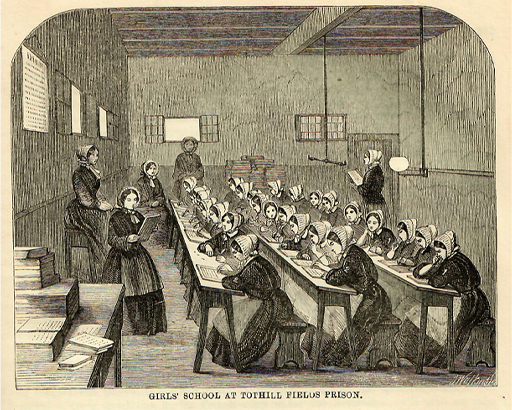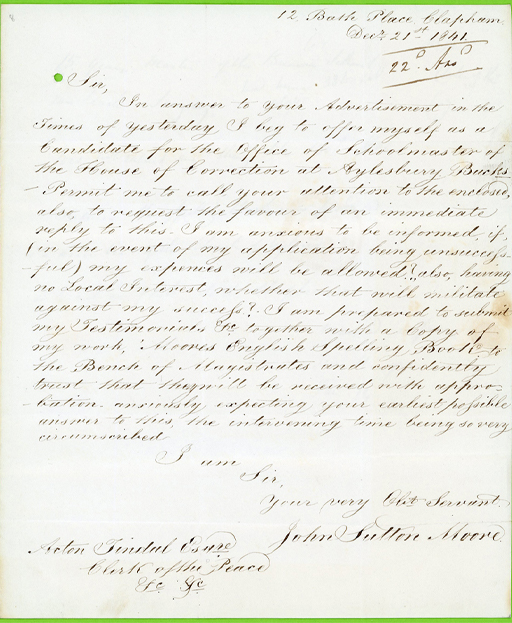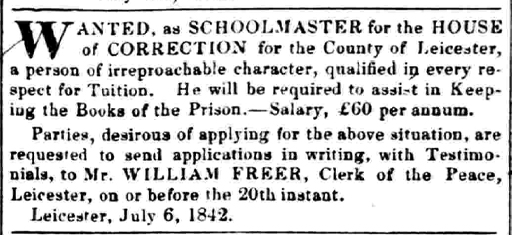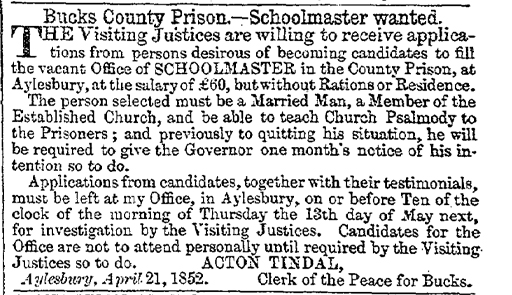4 The rise of the prison schoolmaster
The period 1835 to 1855 witnessed the rise of the prison schoolmaster. This was in part a consequence of the imposition of silence and separation. Schoolmasters were often employed to replace prisoners who had been teaching. The new importance given to education meant that prison officials were eager to employ qualified teachers rather than relying on the efforts of family members and subordinate officers. Regulations for local prisons in England and Wales published by the Home Office in 1840 insisted that schoolmasters and schoolmistresses had to be employed in large prisons (Regulations for Prisons, 1840, rule 178).

At the same time, prison visiting by charitable ladies and gentlemen began to decline. The famous prison visitors Elizabeth Fry and Sarah Martin both died in the mid-1840s, removing two powerful examples of philanthropy for others to imitate. Prison officials had also become wary of prison visitors who were not in their pay and so not under their control. Prisons were increasingly becoming closed worlds, cut off from civilian life outside.
Activity 3 Employing teachers
Take a look at the following two advertisements for prison schoolmasters which appeared in local newspapers in 1842 and 1852. Answer the following question:
- What qualifications must applicants have for these roles?
WANTED, as SCHOOLMASTER for the HOUSE of CORRECTION for the County of Leicester, a person of irreproachable character, qualified in every respect for Tuition. He will be required to assist in Keeping the Books of the Prison – Salary, £60 per annum.
Parties, desirous of applying for the above situation, are requested to send applications in writing, with Testimonials, to Mr. WILLIAM FREER, Clerk of the Peace, Leicester, on or before the 20th instant.
Leicester, July 6, 1842.
Bucks County Prison. – Schoolmaster wanted.
The Visiting Justices are willing to receive applications from persons desirous of becoming candidates to fill the vacant Office of SCHOOLMASTER in the County Prison, at Aylesbury, at the salary of £60, but without Rations or Residence.
The person must be a Married Man, a Member of the Established Church, and be able to teach Church Psalmody to the Prisoners; and previously to quitting his situation, he will be required to give the Governor one month’s notice of his intention so to do.
Applications from candidates, together with their testimonials, must be left at my Office, in Aylesbury, on or before Ten of the clock of the morning of Thursday the 13th day of May next, for investigation by the Visiting Justices. Candidates for the Office are not to attend personally until required by the Visiting Justices so to do.
ACTON TINDAL
Aylesbury, April 21, 1852 Clerk of the Peace for Bucks.
Discussion
The advertisement for a schoolmaster for Leicester House of Correction calls for someone who is ‘qualified in every respect for tuition’. It’s vague, and does not mention a specific qualification or training. The advertisement for a schoolmaster for the Buckingham County Prison does not even mention teaching qualifications. This was not unusual. Before the 1840s, there were only limited opportunities for teacher training in England and Wales. In 1846, a state-financed pupil-teacher system was established through which certificates were issued to those who completed a teaching apprenticeship, but there remained many elementary school teachers without certificates (Smelser, 1991, pp. 297–300).
Profiles of prison schoolmasters in annual reports and surviving applications for prison schoolmaster posts indicate that men with experience of teaching in elementary schools, and sometimes teacher training, applied and were appointed (see, for example, John Sutton Moore’s letter of application in Figure 10). The prison offered an alternative – and sometimes better paid – career path for male teachers.

The advertisement from Buckingham County Prison does insist that the schoolmaster must be a member of the Church of England. This was a common requirement. Instruction in reading and writing had a religious purpose. Church of England prison chaplains were often deeply suspicious of teachers from other denominations (such as Methodists, Quakers, Independents). This suspicion led to many prison visitors, who tended to be Dissenters rather than Anglicans, being ejected.
You might have noticed that both of these were full-time posts. This was another important trend in the rise of the schoolmaster. Prison officials wanted complete control over those they employed and part-time hours were a hindrance to this. Especially in smaller prisons, time spent not teaching had to be filled with other duties. At Leicester House of Correction, the schoolmaster was required to do clerical work. At some prisons, he was given warder duties.
Both advertisements were for schoolmasters. Not much has been said about schoolmistresses. Their numbers also grew but their rise was far less apparent. Because of the small populations of female prisoners in many prisons, matrons continued to be given schoolmistress duties where possible. Occasionally, a schoolmistress was employed on a part-time basis. Career paths for prison schoolmistresses were only really available in the convict sector where populations of female prisoners were larger and more stable.


